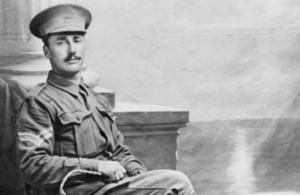WW1 New Zealand VC recipient Thomas Cooke
The story of New Zealand First World War Victoria Cross recipient Thomas Cooke.

Credit: Australian War Memorial A02649
16 men from New Zealand received the Victoria Cross, Britain’s highest award for gallantry, during the First World War. As part of the Centenary Commemorations the people of the United Kingdom marked their gratitude to those courageous men by presenting a bronze memorial plaque to their home country engraved with their names. The plaque is now displayed in the grounds of the New Zealand Parliament, Wellington. This archive tells their stories.
Name: Thomas Cooke
DOB: 5 July 1881
Place of Birth: Kaikoura, Marlborough, New Zealand
Date of Action: 24 to 25 July 1916
Place of Action: Pozières, France
Rank: Private
Regiment: 8th Infantry Battalion, Australian Imperial Force
Thomas Cooke was born on 5 July 1881 in Kaikoura, New Zealand. He became a carpenter, married, and had a great love of band music. In 1912, he emigrated to Melbourne, Australia, with his wife and three children where he worked as a labourer.
In February 1915, Cooke enlisted as a private in the Australian Imperial Force. He later joined the 8th Battalion with whom he served in France from April 1916.
Private Cooke was awarded his Victoria Cross posthumously “For most conspicuous bravery” on 24 to 25 July 1916, in Pozières during the Battle of the Somme. He was ordered, with his Lewis-gun team, to a dangerous part of the newly captured line. With heavy enemy fire and little cover, all the rest of his team were killed, but Cooke continued to hold out alone. When help finally arrived, Private Cooke was found dead at his gun. His citation notes:
After a Lewis gun had been disabled, he was ordered to take his gun and gun-team to a dangerous part of the line. Here he did fine work, but came under very heavy fire, with the result that finally he was the only man left. He still stuck to his post, and continued to fire his gun. When assistance was sent he was found dead beside his gun. He set a splendid example of determination and devotion to duty.
His body was lost in the subsequent fighting, but his name is commemorated on the roll of honour at the Australian war memorial, Villers-Bretonneux.